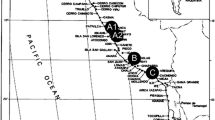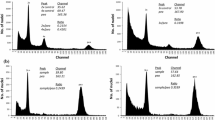Abstract
Controlled pollination (CP) was used to produce four reciprocal crosses of the interspecific hybrid between Acacia auriculiformis and A. mangium, and one additional reciprocal cross within each parental species. There were no reciprocal effects on seed yield index (filled seeds per 100 flowers pollinated) and germination success for filled seeds. The CP families, together with four additional CP hybrid families, one open-pollinated (OP) family from seed orchards of each parental species and a commercial Acacia hybrid (A. mangium × A. auriculiformis) clone were planted in a field trial in central Vietnam. Forty months after planting the pure-species A. mangium families, with diameter at breast height (DBH), averaging 10.8 cm, grew faster than those of A. auriculiformis (mean 8.5 cm). Nursery gate survival and mean height and diameter at breast height at 40 months of the interspecific hybrid families were not affected by crossing direction. The mean height and DBH of all hybrid families was close to the mid-point of the two parental species. Inheritance of phyllode length and breadth was non-additive; interspecific hybrid families had phyllode length and width much closer to that of A. auriculiformis than to A. mangium, however there was no consistent reciprocal effect for these traits. It is concluded that, at least for the test environment under study, crossing direction is not likely to be of practical importance in hybrid breeding of these species.



Similar content being viewed by others
Availability of data and material
All raw data is available in Excel files on request.
Code availability
n.a.
References
Bon PV, Harwood CE, Nghiem NQ, Thinh HH, Kien ND (2020) Comparing wood density, heartwood, proportion and bark thickness of diploid and triploid Acacia hybrid clones in Vietnam. J Trop For Sci 32(2):206–216
Chi NM, Thu PQ, Mohammed C (2019) Screening disease resistance of Acacia auriculiformis clones against Ceratocystis manginecans by artificial and natural inoculation methods. Australas Plant Pathol 48:617–624. https://doi.org/10.1007/s13313-019-00665-9
Flood PJ, Theeuwen TPJM, Schneeberger K et al (2020) Reciprocal cybrids reveal how organellar genomes affect plant phenotypes. Nature Plants 6:13. https://doi.org/10.1038/s41477-019-0575-9
Griffin R, Harbard J, Centurion C, and Santini P (2000) Breeding Eucalyptus grandis x globulus and other inter-specific hybrids with high inviability—problem analysis and experience in Shell Forestry projects in Uruguay and Chile. In: Proceedings of QFRI/CRC-SPF symposium, 9–14 April 2000, Noosa Queensland Australia. Compiled by Dungey HS, Dieters MJ and Nikles DG Dept. Primary Industry, Brisbane
Griffin AR, Vuong TD, Harbard JL, Wong CY, Brooker C, Vaillancourt RE (2010) Improving controlled pollination methodology for breeding Acacia mangium Willd. New For 40:131–142. https://doi.org/10.1007/s11056-010-9188-x
Griffin AR, Nghiem QC, Harbard JL et al (2015) Breeding polyploid varieties of tropical acacias: progress and prospects. Southern Forests 77:41–50. https://doi.org/10.2989/20702620.2014.999303
Harwood CE, Nambiar EKS (2014) Productivity of acacia and eucalypt plantations in South East Asia. ii. trends and variations. Int For Rev 16:249–260
Harwood CE, Ha HT, Tran HQ, Butcher PA, Williams ER (2004) The effect of inbreeding on early growth of Acacia mangium in Vietnam. Silvae Genet 53:65–69
Harwood CE, Hardiyanto EB, Yong WC (2015) Genetic improvement of tropical acacias: achievements and challenges. South For 77:11–18. https://doi.org/10.2989/20702620.2014.999302
Harwood CE, Nambiar EKS, Dinh PX, Toan LX, Quang LT (2017) Managing wood production from small grower acacia hybrid plantations on eroded soils in central Vietnam. Aust For 80:286–293. https://doi.org/10.1080/00049158.2017.1395200
Huong VD, Nambiar EKS, Hai NX, Ha KM, Dang NV (2020) Sustainable management of Acaoia auriculiformis plantations for wood production over four successive rotations in South Vietnam. Forests 11:550. https://doi.org/10.3390/f11050550
Kato K, Yamaguchi S, Chigira O, Hanaoka S (2014) Comparative study of reciprocal crossing for establishment of Acacia hybrids. J Trop For Sci 26:469–483
Kenrick J (2003) Review of pollen-pistil interactions and their relevance to the reproductive biology of Acacia. Aust Syst Bot 16:119–130. https://doi.org/10.1071/sb02005
Kha LD (2001) Studies on the use of natural hybrids between Acacia mangium and Acacia auriculiformis in Vietnam. Agriculture Publishing House, Hanoi, Vietnam
Kha LD, Harwood CE, Kien ND, Baltunis BS, Hai ND, Thinh HH (2012) Growth and wood basic density of acacia hybrid clones at three locations in Vietnam. New For 43:13–29. https://doi.org/10.1007/s11056-011-9263-y
Kimball S, Campbell DR, Lessin C (2008) Differential performance of reciprocal hybrids in multiple environments. J Ecol 96:1306–1318. https://doi.org/10.1111/j.1365-2745.2008.01432.x
La Farge T, Hunt DL (1980) Direction of pollination affects seed productivity in (shortleaf x loblolly) x loblolly hybrids. Research Note S E -294 U. S. Dept. Agriculture Forest Service
Le S, Harwood CE, Griffin AR, Do SH, Ha TH, Ratnam W, Vaillancourt RE (2017) Using SSR markers for hybrid identification and resource management in Vietnamese Acacia breeding programs. Tree Genet Genomes. https://doi.org/10.1007/s11295-017-1184-2
Le S, Harwood CE, Nghiem CQ, RodGriffin A, Vaillancourt RE (2019) Patterns of hybrid seed production in adjacent seed orchards of Acacia auriculiformis and A. mangium in Vietnam. Ann For Sci 76:10. https://doi.org/10.1007/s13595-019-0823-1
Lopez GA, Potts BM, Vaillancourt RE, Apiolaza LA (2003) Maternal and carryover effects on early growth of Eucalyptus globulus. Can J For Res Rev Can Rech For 33:2108–2115. https://doi.org/10.1139/x03-132
MARD (2002) The basic information of main soil units of Vietnam. Ministry of Agriculture and Rural Development, National Institute for Soils and Fertilizers, Hanoi, Vietnam
Mousseau TA, Fox CW (1998) The adaptive significance of maternal effects. Trends Ecol Evolut 13:403–407. https://doi.org/10.1016/s0169-5347(98)01472-4
Nambiar EKS, Harwood CE, Kien ND (2015) Acacia plantations in Vietnam: research and knowledge application to secure a sustainable future. South For 77:1–10. https://doi.org/10.2989/20702620.2014.999301
Nambiar EKS, Harwood CE, Mendham DS (2018) Paths to sustainable wood supply to the pulp and paper industry in Indonesia after diseases have forced a change of species from acacia to eucalypts. Aust For 81:148–161. https://doi.org/10.1080/00049158.2018.1482798
Nghiem CQ, Harwood CE, Harbard JL, Griffin AR, Ha TH, Koutoulis A (2010) Floral phenology and morphology of colchicine-induced tetraploid Acacia mangium compared with diploid A. mangium and A. auriculiformis: implications for interploidy pollination. Aust J Bot 59:582–592. https://doi.org/10.1071/bt11130
Nghiem QC, Harbard JL, Harwood CE, Griffin AR, Ha TH, Koutoulis A (2013) Pollen-pistil interactions between autrotetraploid and diploid Acacia mangium and diploid A. auriculiformis. J Trop For Sci 25:96–110
Nghiem QC, Griffin AR, Harwood CE, Harbard JL, Huy TH, Koutoulis A (2016) Seed development following reciprocal crossing among autotetraploid and diploid Acacia mangium and diploid A. auriculiformis. Aust J Bot 64:20–31. https://doi.org/10.1071/bt15130
Nghiem CQ et al (2018) Reduced fertility in triploids of Acacia auriculiformis and its hybrid with A. mangium. Euphytica 214(4):77
Potts BM, Dungey HS (2004) Interspecific hybridization of Eucalyptus: key issues for breeders and geneticists. New For 27:115–138. https://doi.org/10.1023/a:1025021324564
Roach DA, Wulff RD (1987) Maternal effects in plants. Annu Rev Ecol Syst 18:209–235. https://doi.org/10.1146/annurev.es.18.110187.001233
Sedgley M, Harbard J, Smith RMM, Wickneswari R, Griffin AR (1992) Reproductive biology and interspecific hybridization of Acacia mangium and Acacia auriculiformis Cunn A ex Benth. (Leguminosae, Mimosoideae). Aust J Bot 40:37–48. https://doi.org/10.1071/bt9920037
Son DH, Harwood CE, Kien ND, Griffin AR, Thinh HH, Son L (2018) Evaluating approaches for developing elite acacia hybrid clones in Vietnam: towards an updated strategy. J Trop For Sci 30:476–487. https://doi.org/10.26525/jtfs2018.30.5.476487
Stanton BJ (2005) The effect of reciprocal hybridization on reproduction of the intersectional cross, Populus x Generosa. For Genet 12(2):131–140
Suitor S, Potts BM, McGowen MH, Pilbeam DJ, Brown PH, Gracie AJ, Gore PL (2009) The relative contribution of the male and female to the variation in reproductive success in Eucalyptus globulus. Silvae Genet 58:129–138. https://doi.org/10.1515/sg-2009-0017
Wesselingh RA (2007) Pollen limitation meets resource allocation: towards a comprehensive methodology. New Phytol 174:26–37. https://doi.org/10.1111/j.1469-8137.2007.01997.x
Zhu YA, Wu SJ, Xu JM et al (2017) Genetic parameters for growth traits and stem-straightness in Eucalyptus urophylla x E. camaldulensis hybrids from a reciprocal mating design. Euphytica 213:16. https://doi.org/10.1007/s10681-017-1923-3
Acknowledgements
We thank Vietnam’s Ministry of Agriculture and Rural Development (MARD) for financial support of this study, and the Australian Centre for International Agricultural Research and the Crawford Foundation for supporting the Australian co-authors’ participation. The support of this study by Drs Ha Huy Thinh and Pham Xuan Dinh is gratefully acknowledged. Dr David Bush provided helpful assistance with statistical analysis, and staff of the Vietnam Academy of Forest Sciences assisted with trial establishment, management and assessment.
Funding
Vietnam’s Ministry of Agriculture and Rural Development (MARD) provided financial support of this study. The Australian Centre for International Agricultural Research and the Crawford Foundation supported the Australian co-authors’ participation.
Author information
Authors and Affiliations
Corresponding author
Ethics declarations
Conflicts of interest
They authors declare they have no conflict of interest.
Ethics approval
n.a.
Consent to participate
n.a.
Consent for publication
n.a.
Additional information
Publisher's Note
Springer Nature remains neutral with regard to jurisdictional claims in published maps and institutional affiliations.
Rights and permissions
About this article
Cite this article
Chi, N.Q., Harwood, C., Griffin, R. et al. Are maternal and reciprocal effects important in breeding the inter-specific hybrid between Acacia auriculiformis and A. mangium?. Euphytica 216, 176 (2020). https://doi.org/10.1007/s10681-020-02711-w
Received:
Accepted:
Published:
DOI: https://doi.org/10.1007/s10681-020-02711-w




